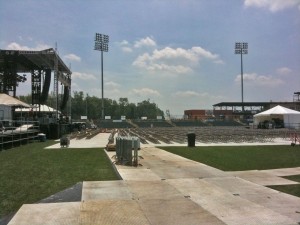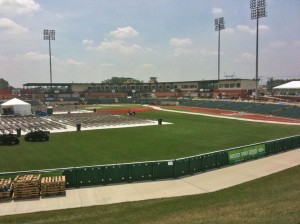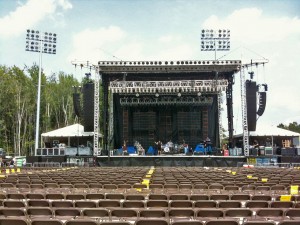OK, I’ll admit it. This is going to be another post about me and a recent Joe Nichols show. But the angle may be a little different than what you might be expecting. And of course, I’ll throw in some visuals along the way, for those who get bored with all those silly words.

Unlike the last couple years my son has worked for Joe Nichols, their tour has made several stops in the area so far this year. Like any proud father, I make it a point to visit with Chris and the guys whenever the schedule permits. So this past Thursday, I headed off down the Ohio Turnpike to Avon, Ohio. Joe was opening for country superstar Alan Jackson at All Pro Freight Stadium with ticket proceeds benefitting the Boys & Girls Club of Lorain County. It didn’t really hit me at first. But as the day went on, it began to dawn on me just how much work had to be done to bring this event to fruition – much of the work being done by volunteers. Now, I’m not saying a great deal of hard work isn’t required for every concert event. But most of Joe’s shows that I’ve attended, were held at dedicated music venues or fairgrounds, where much of the needed infrastructure was already in place. In contrast, this show was being staged in a Frontier League baseball stadium. So virtually EVERYTHING had to be procured, brought in, setup, staffed, and struck in a very short time frame, while protecting the delicate field and grounds, and all on a minimal operating budget. No small feat, to be sure.
Walt Disney World, renowned for their customer care, has made it known that the most lasting impressions a customer experiences are from their first and last points of contact with a company. So the folks at Disney go out of their way to make sure those customer experiences are the very best possible. And here is why I think Disney is completely correct. When I arrived at the stadium to meet Chris and the guys around 11:30am, it was already in the mid 80s, with a relentless sun bludgeoning the North Coast with its radiation and heat. The first person I encountered as I entered the parking lot, was a pleasant looking middle-aged guy in cargo shorts and a yellow staff t-shirt. I stopped to tell him why I was there, showed him my laminated credentials, and we exchanged small talk about where I should park, etc. As I turned in to the appropriate parking area, I was glad this guy had been pleasant and respectful toward me – not always the case for these parking/traffic workers. But other than that, I didn’t give the guy a second thought… until later.

After checking in with the band and crew at Joe’s bus, I wandered into the stadium to do a little reconnaissance for shooting the show that night. I saw the large stage with lights and sound already rigged, an elevated walkway to get the large rolling cases to the stage without damaging the field, the front of house sound and light area, and a sea of folding chairs in neatly arranged, labeled rows. OK, that all seemed pretty typical, I thought. But as I walked around the grounds, the magnitude of this setup started sinking in. First, before one guitar pick was brought in, the field had to be protected. There was plastic rolled sheeting on the artificial turf, covered with 4′ x 8′ sheets of white, heavy duty plastic-type diamondplate for the heavy-duty traffic areas. The entire seating area was covered with a type of interlocking white plastic “brick” sheets. Anywhere the stage structure touched the ground, there were large blocks of wood or sheets of plywood. There were several industrial-sized generator trucks backstage for all the sound and lighting power. There were several high-end video cameras and a complete video control room backstage. There was a tented area adjacent to the stadium for crew and band catering. There were 4 or 5 equipment semi-trucks, 5 band and crew tour busses, hundreds of crew and volunteers and countless golf carts darting around carrying supplies or personnel. All in all, it was as if a small town had sprung up here.
Obviously, all of the technical aspects of this event (staging, lights, sound, TV, etc.) were being carried out by professionals who do this day in and day out. And I think I am correct in assuming that these crew people are all being paid their normal rates. But there were countless volunteers handling everything else – laying down the field mats, setting up the chairs, running supplies to and fro, and directing traffic. And remember the guy in the parking lot with the yellow shirt? I passed him as I went out to get camera gear out of my car around 4pm – he was still standing in the same spot, policing the incoming cars. By now, it was probably 90 degrees or better with full sun still beating down. As I returned with a Pelican case full of camera gear, I asked if he needed some water. “You have some with you?” he replied. I told him, “no, but I’ll go get you some.” When I reached the bus, I stowed my gear and grabbed a bottled water and hoofed it back to my pal in the yellow shirt. He was genuinely thankful for the water.

As I walked away, I thought more about all the unseen people working hard for days, perhaps weeks, on getting this event together. Their names wouldn’t be on the posters or the web sites, they wouldn’t be standing in the spotlight that evening, and they wouldn’t be thanked personally by Alan Jackson or Joe Nichols or the local news channel anchor during her announcements between sets. But they all selflessly put forth effort behind the scenes to make this event a success, and in turn helped raise money for an organization that would eventually benefit their community. I was humbled. Here I was on an air-conditioned tour bus, drinking cold, bottled water, watching satellite TV, eating catered meals a few feet away, and having full access to the entire venue with the wave of a plastic badge. Yet, many of us (me, band & crew) had been complaining about the warm weather, the food at catering, the bathroom and shower facilities, and the slow internet connection on the bus. Thinking about the volunteers working so hard with no reward but the satisfaction of helping, put a lot of things in perspective for me that evening. And when I finally left the show that night about 10:30pm, whom do you think I saw standing at the entrance directing traffic? Yep, my friend in the yellow shirt. As I pulled out of the parking area, he gave me a friendly nod and smiled. I reciprocated and headed home. I think Disney would have been proud.
